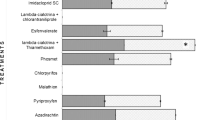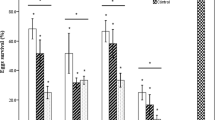Abstract
The green lacewing, Chrysoperla carnea, Stephens (Neu.: Chrysopidae) is one of the most important predators for insect pests such as whiteflies, thrips, psyllids and aphids that ignificantly decrease their populations. In the current study, lethal (LC50) and sublethal effects (LC30) of three insecticides; clothianidin, tebufenozide and flupyradifurone on first instar larvae of C. carnea (<one-day old) and their biological characteristics were evaluated using fertility life table method. Bioassays were conducted by contact method with glass petri-dishes (10 cm diameter). All experiments were conducted at controllable conditions of 25 ± 1 C°, 60 ± 5% and a photoperiod 16:8 h (L:D). The results revealed that LC50 for clothianidin, tebufenozide and flupyradifurone were 8.55, 336.12 and 642.02, respectively. Moreover, the life table response experiment shows that the values of rm and R0 due to LC30 for clothianidin, tebufenozide and flupyradifurone were 0.13, 0.13 and 0.15 per day and 95.72, 97.00 and 136.27 offspring, respectively. At the same time, rm and R0 in the control group were 0.15 per day and 143.26 offspring. Furthermore, the highest survival rate of C. carnea was observed in tebufenozide (54 days) but after control treatment, the lowest survival rate was related to clothianidin (46 days). Results reveal that longevity and life span of both sexes in three treatments were different from the control. According to the IOBC-system, comparing the total effects indicated that clothianidin (77.83%) was classified as slightly harmful while tebufenozide (20.43%) and flupyradifurone (12.89%) were categorized as harmless classes. Hence, based on obtained results, it can be concluded that flupyradifurone than clothianidin are harmless while tebufenozide is less hazardous on C. carnea population. We also measured the esterase enzyme activities of the C. carnea as biomarkers of sublethal exposure to insecticides. The results showed that alpha and beta-esterase activity in treated insects with clothianidin and flupyradifurone was increased (compared to the control), while the enzymatic activity was reduced in insects with tebufenozide treatment.



Similar content being viewed by others
References
Abbott W (1925) A method of computing the effectiveness of an insecticide. J Econ Entomol 18:265–267
Ahmadi F (2009) A study on side effects of abamectin and imidacloprid, on biological and biochemical parameters of Cryptolaemus montrouzieri (Col., Coccinellidae). M.Sc. thesis of agricultural entomology, Zabol University, Iran. 120 pp. (in persian language)
Andrewartha HG, Birch L (1954). The distribution and abundance of aninmals (first edition). University of Chicago Press
Azema M, Mirabzadeh A (2004) Issues on different aspects of applying natural enemies for biological control of insect pests. Sepehr publication center, Tehran, Iran, (in persian language). 213 pp
Barzman M, Bàrberi P, Birch ANE, Boonekamp P, Dachbrodt-Saaydeh S, Graf, B.,& Lamichhane, J. R. (2015) Eight principles of integrated pest management. Agron Sustain Dev 35(4):1199–1215
Booth LH, Wratten SD, Kehrli P (2007) Effects of reduced rates of two insecticides on enzyme activity and mortality of an aphid and its lacewing predator. J Econ Entomol 100(1):11–19
Brunner JF, Dunley JE, Doerr MD, Beers EH (2001) Effect of pesticides on Colpoclypeus florus (Hymenoptera: Eulophidae) and Trichogramma platneri (Hymenoptera: Trichogrammatidae), parasitoids of leafrollers in Washington. J Econ Entomol 94:1075–1084
Chi H (2018) TWOSEX-MSChart: a computer program for the age-stage, two-sex life table analysis. National Chung Hsing University, Taichung
Consoli F, Parra J, Hassan S (1998) Side- effects of insecticides used in tomato fields on the egg parasitoid Trichogramma pretiosum Riley (Hym., Trichogrammatidae), a natural enemy of Tuta absoluta (Meyrick)(Lep., Gelechiidae). J Appl Entomol 122:43–47
Corrales N, Campos M (2004) Populations, longevity, mortality and fecundity of Chrysoperlacarnea (Neuroptera, Chrysopidae) from olive-orchards with different agricultural management systems. Chemosphere 57:1613–1619
Croft BA (1990) Arthropod biological control agents and pesticides, John Wiley and Sons Inc., New York. 723 pp
Delpuech J, Bardon C, Boulétreau M (2005) Increase of the behavioral response to kairomones by the parasitoid wasp Leptopilina heterotoma surviving insecticides. Arch Environ Contam Toxicol 49:186–191
Desneux N, Decourtye A, Delpuech J-M (2007) The sublethal effects of pesticides on beneficial arthropods. Annu Rev Entomol 52:81–106
Dhadialla TS, Carlson GR, Le DP (1998) New insecticides with ecdysteroidal and juvenile hormone activity. Annu Rev Entomol 43(1):545–569
Elzen G, Maldonado S, Rojas M (2000) Lethal and sublethal effects of selected insecticides and an insect growth regulator on the boll weevil (Coleoptera: Curculionidae) ectoparasitoid Catolaccus grandis (Hymenoptera: Pteromalidae). J Econ Entomol 93:300–303
Farhadi R, Allahyari H, Chi H (2011) Life table and predation capacity of Hippodamia variegata (Coleoptera: Coccinellidae) feeding on Aphis fabae (Hemiptera: Aphididae). Biol Control 59:83–89
Golmohammadi G, Hejazi M, Iranipour S, Mohammadi S (2009) Lethal and sublethal effects of endosulfan, imidacloprid and indoxacarb on first instar larvae of Chrysoperla carnea (Neu.: Chrysopidae) under laboratory conditions. J Entomol Soc Iran 28:37–47
Jervis MA (2007) (Ed.) Insects as natural enemies: a practical perspective, Springer Science & Business Media, Wales, United Kingdom. 453pp.
Jeschke P, Nauen R, Gutbrod O, Beck ME, Matthiesen S, Haas M, Velten R (2015) Flupyradifurone (Sivanto™) and its novel butenolide pharmacophore: structural considerations. Pestic Biochem Physiol 121:31–38
KAVOUSI A, TALEBI K (2003) Side-effects of three pesticides on the predatory mite, Phytoseiulus persimilis (Acari: Phytoseiidae). Exp Appl Acarol 31:51–58
Komeza N, Fouillet P, Boulétreau M, Delpuech J (2001) Modification, by the insecticide chlorpyrifos, of the behavioral response to kairomones of a parasitoid wasp, Leptopilina boulardi. Arch Environ Contam Toxicol 41:436–442
Lucas E, Giroux S, Demougeot S, Duchesne RM, Coderre D (2004) Compatibility of a natural enemy, Coleomegilla maculata lengi (Col., Coccinellidae) and four insecticides used against the Colorado potato beetle (Col., Chrysomelidae). J Appl Entomol 128:233–239
Matowo J, Kulkarni MA, Mosha FW, Oxborough RM, Kitau JA, Tenu F, Rowland M (2010) Biochemical basis of permethrin resistance in Anopheles arabiensis from lower Moshi, North-Eastern Tanzania. Malar J 9:193
Medina P, Smagghe G, Budia F, Tirry L, Vinuela E (2003) Toxicity and absorption of azadirachtin, diflubenzuron, pyriproxyfen, and tebufenozide after topical application in predatory larvae of Chrysoperla carnea (Neuroptera: Chrysopidae). Environ Entomol 32:196–203
Olszak RW, Ceryngier P, Warabieda W (2004) Influence of some pesticides on fe- cundity and longevity of Coccinella septempunctata and Adalia bipunctata (Col., cocci- nellidae) under laboratory conditions. Pesticides & Beneficial Organisms IOBC/wprs Bul 27:105
Overmeer W, van Zon A (1982) A standardized method for testing the side effects of pesticides on the predacious mite, Amblyseius potentillae [Acarina: Phytoseiidae]. Entomophaga 27:357–363
Rezaei M, Talebi K, Naveh V, Kavousi A (2007) Impacts of the pesticides imidacloprid, propargite, and pymetrozine on Chrysoperla carnea (Stephens)(Neuroptera: Chrysopidae): IOBC and life table assays. BioControl 52:385–398
Robertson JL, Russell RM, Preisler HK, Savin NE (2007) Pesticide bioassays with arthropods (second edition). CRC Press. 224 pp.
Rumpf S, Hetzel F, Frampton C (1997) Lacewings (Neuroptera: Hemerobiidae and Chrysopidae) and integrated pest management: enzyme activity as biomarker of sublethal insecticide exposure. J Econ Entomol 90(1):102–108
SAS Institute (1990). SAS/STAT user’s guide: version 6 (Vol. 2). SAS institute Incorporated.
SPSS Institute (2017) SPSS for windows. In: Version 24. SPSS Institute Inc, Chicago
Stark JD, Banks JE (2003) Population-level effects of pesticides and other toxicants on arthropods. Annu Rev Entomol 48:505–519
Stark JD, Banken JA, Walthall WK (1998) The importance of the population perspective for the evaluation of side-effects of pesticides on beneficial species. Ecotoxicology. Springer
Stark JD, Banks JE, Acheampong S (2004) Estimating susceptibility of biological control agents to pesticides: influence of life history strategies and population structure. Biol Control 29:392–398
Sterk G, Hassan S, Baillod M, Bakker F, Bigler F, Blümel S, Bogenschütz H, Boller E, Bromand B, Brun J (1999) Results of the seventh joint pesticide testing programme carried out by the IOBC/WPRS-working group ‘pesticides and beneficial organisms’. BioControl 44:99–117
Tan Y, Biondi A, Desneux N, Gao XW (2012) Assessment of physiological sublethal effects of imidacloprid on the mirid bug Apolygus lucorum (Meyer-Dür). Ecotoxicology 21(7):1989–1997
Tauber MJ, Tauber CA, Daane KM, Hagen KS (2000) Commercialization of predators: recent lessons from green lacewings (Neuroptera: Chrysopidae: Chrosoperla). Am Entomol 46:26–38
Van Asperen K (1962) A study of housefly esterase by means of a sensitive colorimetric method. J Insect Physiol 8:401–416
Funding
This study was funded by Iranian Plant Protection Research Institute which is acknowledged.
Author information
Authors and Affiliations
Corresponding author
Ethics declarations
Conflict of interest
The authors declare that they have no conflict of interest.
Additional information
Publisher’s note
Springer Nature remains neutral with regard to jurisdictional claims in published maps and institutional affiliations.
Rights and permissions
About this article
Cite this article
Golmohammadi, G., Torshizi, HR.R., Vafaei-Shooshtari, R. et al. Lethal and sublethal effects of three insecticides on first instar larvae of green lacewing, Chrysoperla carnea, Stephens. Int J Trop Insect Sci 41, 2351–2359 (2021). https://doi.org/10.1007/s42690-020-00407-1
Received:
Accepted:
Published:
Issue Date:
DOI: https://doi.org/10.1007/s42690-020-00407-1




